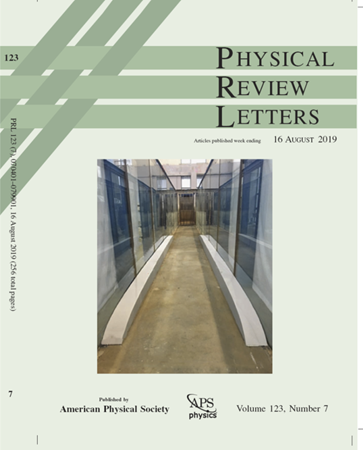Illuminating Black Hole Shadows with Dark Matter Annihilation
IF 9
1区 物理与天体物理
Q1 PHYSICS, MULTIDISCIPLINARY
引用次数: 0
Abstract
The Event Horizon Telescope (EHT) has significantly advanced our ability to study black holes, achieving unprecedented spatial resolution and revealing horizon-scale structures. Notably, these observations feature a distinctive dark shadow—primarily arising from faint jet emissions—surrounded by a bright photon ring. Anticipated upgrades of the EHT promise substantial improvements in dynamic range, enabling deeper exploration of low-background regions, particularly the inner shadow defined by the lensed equatorial horizon. Our analysis shows that observations of these regions transform supermassive black holes into powerful probes for annihilating dark matter, which is expected to accumulate densely in their vicinity. By analyzing the black hole image morphology and performing electron-positron propagation calculations in realistic plasma backgrounds derived from general relativistic magnetohydrodynamic simulations, we set stringent constraints on dark matter annihilation, requiring contributions below the astrophysical emission. These constraints, derived from both current EHT observations and projections for future upgraded arrays, exclude a substantial region of previously unexplored parameter space and remain robust against astrophysical uncertainties, including black hole spin and plasma temperature variations.用暗物质湮灭来照亮黑洞阴影
事件视界望远镜(EHT)极大地提高了我们研究黑洞的能力,实现了前所未有的空间分辨率并揭示了视界尺度结构。值得注意的是,这些观测结果有一个独特的暗影——主要是由微弱的喷流发射引起的——被一个明亮的光子环包围着。EHT的预期升级有望在动态范围上有实质性的改进,能够更深入地探索低背景区域,特别是由透镜赤道地平线定义的内阴影。我们的分析表明,对这些区域的观测将超大质量黑洞转变为消灭暗物质的强大探测器,而暗物质预计会在它们附近密集聚集。通过对黑洞图像形态的分析,并在基于广义相对论磁流体力学模拟的真实等离子体背景下进行电子-正电子传播计算,我们对暗物质湮灭设定了严格的限制,要求贡献低于天体物理发射。这些约束来自当前的EHT观测和对未来升级阵列的预测,排除了以前未探索的参数空间的大量区域,并且对天体物理的不确定性保持稳健,包括黑洞自旋和等离子体温度变化。
本文章由计算机程序翻译,如有差异,请以英文原文为准。
求助全文
约1分钟内获得全文
求助全文
来源期刊

Physical review letters
物理-物理:综合
CiteScore
16.50
自引率
7.00%
发文量
2673
审稿时长
2.2 months
期刊介绍:
Physical review letters(PRL)covers the full range of applied, fundamental, and interdisciplinary physics research topics:
General physics, including statistical and quantum mechanics and quantum information
Gravitation, astrophysics, and cosmology
Elementary particles and fields
Nuclear physics
Atomic, molecular, and optical physics
Nonlinear dynamics, fluid dynamics, and classical optics
Plasma and beam physics
Condensed matter and materials physics
Polymers, soft matter, biological, climate and interdisciplinary physics, including networks
 求助内容:
求助内容: 应助结果提醒方式:
应助结果提醒方式:


